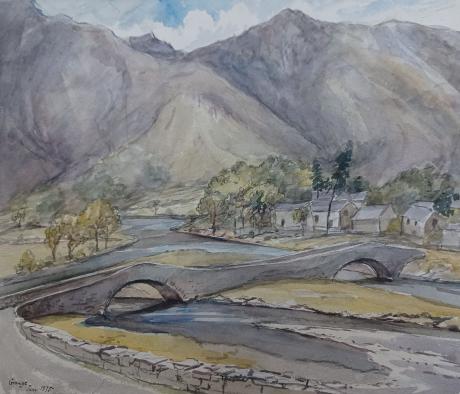inscribed and dated "Double Bridge at Grange Cumbria June 1875" and sigend with initials "LWT"
Tom and Laura Taylor and thence by descent
Grange, often called Grange in Borrowdale, is a village in Borrowdale in the English Lake District. It lies just off the B5289 road to the south of Derwent Water and 4 miles (6.4 km) south of Keswick, in the county of Cumbria, historically part of Cumberland,
Historically part of Cumberland, the village is overlooked by Grange Fell and Castle Crag, which flank either side of the narrow section of Borrowdale in which it sits. Its origins date back to medieval times, when the monks of Furness Abbey built a monastic grange on the site. The double-arched bridge that links the village to the B5289 across the River Derwent was built in 1675. Roadbridge. Rebuilt early C19. Slate rubble. Double continuous bridge over twin arms of the River Derwent. Both of single width and single span with humped backs. Arches have thin slate voussoirs under solid parapet with rubble coping. Holy Trinity Church followed in 1861.
The novelist Hugh Walpole owned Brackenburn, a large house about 1 mile (1.6 km) to the north of Grange, and lived there from 1924 until his death in 1941. Grange in Borrowdale is within the Copeland UK Parliamentary constituency. Trudy Harrison is the Member of Parliament. Before Brexit for the European Parliament its residents voted to elect MEP's for the North West England constituency. For Local Government purposes it is in the Keswick Ward of Allerdale Borough Council and the Keswick Division of Cumbria County Council. Grange in Borrowdale has its own Parish Council; Borrowdale Parish Council.
Grange, more often called 'Grange in Borrowdale', is at the entrance to the 'Jaws of Borrowdale', where the valley narrows, bounded on either side by Castle Crag and Grange Fell. The village is entered over a picturesque double-arched bridge, built in 1675.
The origins of Grange go back to at least the early medieval period. In 1209 Alice de Rumelli sold estates here to the monks of Furness Abbey. The monks cleared the land and established an outlying farm, or grange, in the valley.
The monk's grange gave its name to the hamlet that grew up at the northern end of the valley. The monks harvested oats, barley, and rye, and produced charcoal, but their main focus was wool. They established trade routes, leading packhorses east and south over the surrounding fells.
Most of the picturesque cluster of cottages are built of grey local stone, but one building stands out from the rest for its whitewashed walls. This is the parish church, dedicated to the Holy Trinity and built in 1861 by Miss Margaret Heathcote so that villagers did not have to make the long trek up the valley to the parish church.
Miss Heathcote was notoriously hard to please, and went through 7 curates in just 11 years! There is also a small Methodist church, built nearby in 1878.
Though it seems small and remote, Grange has royal connections. In 1910 Princess Louise, sister of King Edward VII, wanted to create a suitable memorial to her brother on his death. She bought Grange Fell and erected a memorial stone to the king on top of the fell.
Princess Louise also officially presided at the opening ceremony for Brandlehow Wood. one of the first properties purchased by the National Trust. Another very local celebrity was author Hugh Walpole, who lived at Brackenburn, just a mile from Grange, between 1924 and 1941.
Laura Wilson Barker (6 March 1819 – 22 May 1905), was a composer, performer and artist, sometimes also referred to as Laura Barker, Laura W Taylor or "Mrs Tom Taylor".
She was born in Thirkleby, North Yorkshire, third daughter of a clergyman, the Rev. Thomas Barker. She studied privately with Cipriani Potter and became an accomplished pianist and violinist. As a young girl Barker performed with both Louis Spohr and Paganini. She began composing in the mid-1830s - her Seven Romances for voice and guitar were published in 1837. From around 1843 until 1855 she taught music at York School for the Blind. During this period some of her compositions - including a symphony in manuscript, on 19 April 1845 - were performed at York Choral Society concerts.
On 19 June 1855 she married the English dramatist, critic, biographer, public servant, and editor of Punch magazine Tom Taylor. Barker contributed music to at least one of her husband's plays, an overture and entr'acte to Joan of Arc (1871), and provided harmonisations as an appendix to his translation of Ballads and Songs of Brittany (1865).
Her other works include the cantata Enone (1850), the violin sonata A Country Walk (1860), theatre music for As You Like It, (April 1880), Songs of Youth (1884), string quartets, madrigals and solo songs. Her choral setting of Keats's A Prophecy, composed in 1850, was performed for the first time 49 years later at the Hovingham Festival in 1899. The composer was present.
Several of Barker's paintings hang at Smallhythe Place in Kent, Ellen Terry's house.
Barker lived with her husband and family at 84 Lavender Sweep, Battersea. There were two children: the artist John Wycliffe Taylor (1859–1925), and Laura Lucy Arnold Taylor (1863–1940). The Sunday musical soirees at the house attracted many well-known attendees, including Lewis Carroll, Charles Dickens, Henry Irving, Charles Reade, Alfred Tennyson, Ellen Terry and William Makepeace Thackeray.
Tom Taylor died suddenly at his home in 1880 at the age of 62. After his death, his widow retired to Porch House, Coleshill in Buckinghamshire, where she died on 22 May 1905, aged 86.

